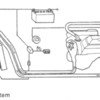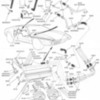George,
Please clarify for me, and maybe others.
You used the terms swirl tank, surge tank, and overflow tank. and your modifications switch the duties (and thus the names) of the tanks in the process. That got me totally confused.
I am going to pose my questions using only 'shorter tank' and 'taller tank'.
FIRST:
By swirl tank you mean the shorter of the two tanks? Right? De Tomaso referred to this as the 'pressure tank'.
AND:
By overflow tank, you mean the taller of the two tanks. Right? De Tomaso referred to this as the 'expansion tank'.
SO:
The shorter tank has two 1 3/8" nipples (top and bottom, has a threaded boss that was the original location for the temp sensor, and a radiator neck that accepts the cap and has a top nipple for a hose that will bleed excess pressurized coolant into the bottom nipple of the taller tank when the radiator cap on the shorter tank opens - right?
The taller tank has a bottom fitting connected to the pressure bleed of the shorter tank, and an overflow hose that will dump excess coolant to the ground, right? Fine, got it.
Now where you sure lost me was when you started outlining the modifications to the tanks.
You say weld up the shorter tank radiator cap fitting. In this action, you remove the entire radiator cap fitting neck, including the small overflow hose nipple, right? Fine, got it. I'm assuming the radiator cap is then moved to the taller tank, yes? But you know about 'assuming'.

You say the small bottom nipple of the taller tank will be re-plumbed to a coolant pump intake port. Fine, got it. The other end of that small hose was attached to the previously removed (and welded) radiator neck nipple on the shorter tank; so that section of hose is no longer used. Fine, got it.
You say install an air bleed at the high point of the shorter tank (which now has a welded top cap). You mean a nipple for a hose, right? As opposed to a petcock for manually releasing air. Fine, got it.
You then say add two small nipples to the taller tank; one for the new top mounted air bleed on the shorter (welded) tank and the other for the air bleed hose that starts at the radiator and runs rearward under the car, right? Fine, got it.
Question - WHERE should these two new, added air bleed nipples be located on the taller tank? Bottom, top or not important? I'm assuming top (above coolant level), but again, you know about 'assuming'.

So the engine is started, coolant is cold. Coolant pump is spinning, but with thermostat closed, coolant is retained in block. When the thermostat opens, coolant is then free to leave the engine through the hose attached at the thermostat and enters the top of the shorter (welded) tank and exits the bottom of that tank towards the radiator. Any air leaving in the coolant from the thermostat exits the system at the new top-mounted air bleed of that shorter tank into the taller tank. If any air is still making its way to the radiator that air exits at the radiator air bleed and feeds into the taller tank.
As the system warms up and pressurizes, the shorter tank should be totally filled with coolant and no air. The taller tank will have some coolant (you said keep it at about one-half) and some air, all under pressure.
QUESTION – When the system is totally pressurized, can any more air can be bled off to the taller tank? I can see at start-up, the coolant pump induced pressure would force out air that had risen to the top of the shorter tank and radiator. But at full operating pressure, what would cause air to migrate to the taller tank? I mean, the whole system is seeing the same pressure, right?
The coolant pump is plumbed to receive coolant from the radiator return line AND the taller tank's bottom nipple.
QUESTION - What source will the coolant pump be pulling coolant from? The radiator return line alone? How?
Isn't it possible for the coolant pump (designed to supply cooled coolant to the engine) to draw HOT coolant from the bottom of the taller tank? I know the hose sizes are vastly different, and I'm guessing the path of least resistance is going to keep the pump receiving most (if not all) of its coolant from the larger radiator return line. In view of this, will the coolant in the small hose from the taller tank see no (or very little) movement into the pump?
When the engine is turned off, it will start cooling down. The volume of the coolant will reduce. Am I correct the pressurized coolant in the taller tank will now be pushed back into the system to fill any air voids?
And then the cycle starts over again.
If I've finally got this right, please let me know.
If not, please let me know where I've gone wrong.
I'm liking what you've proposed, just not sure I've fully grasped what is actually occurring.
Thanks,
Larry




